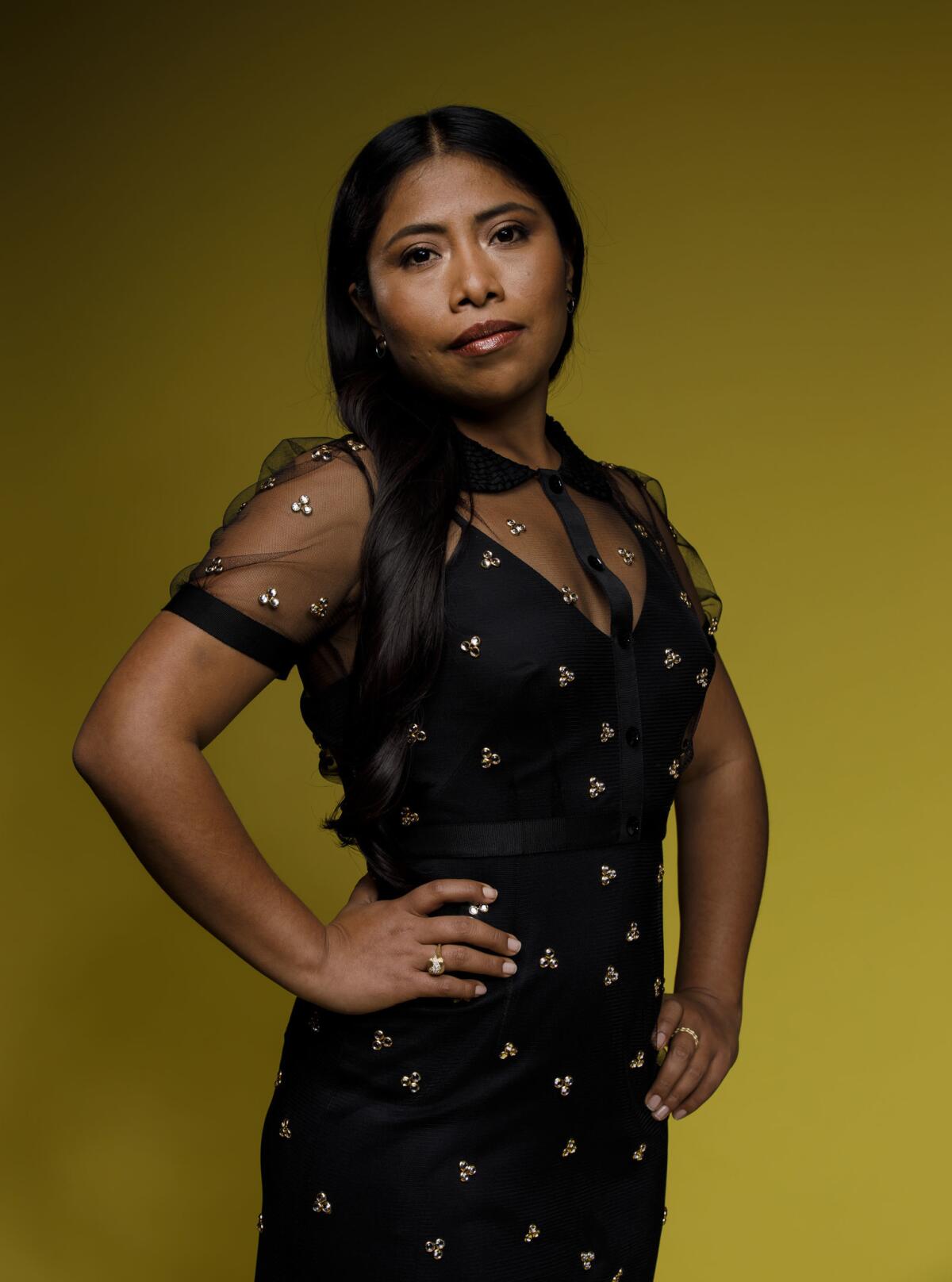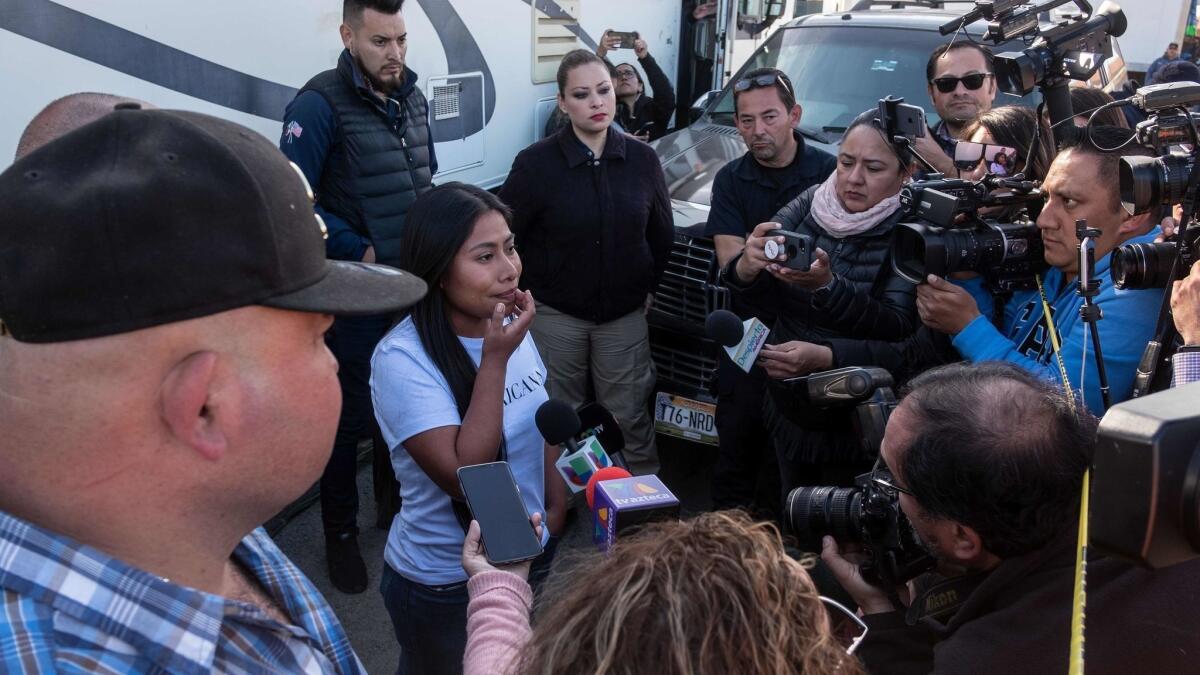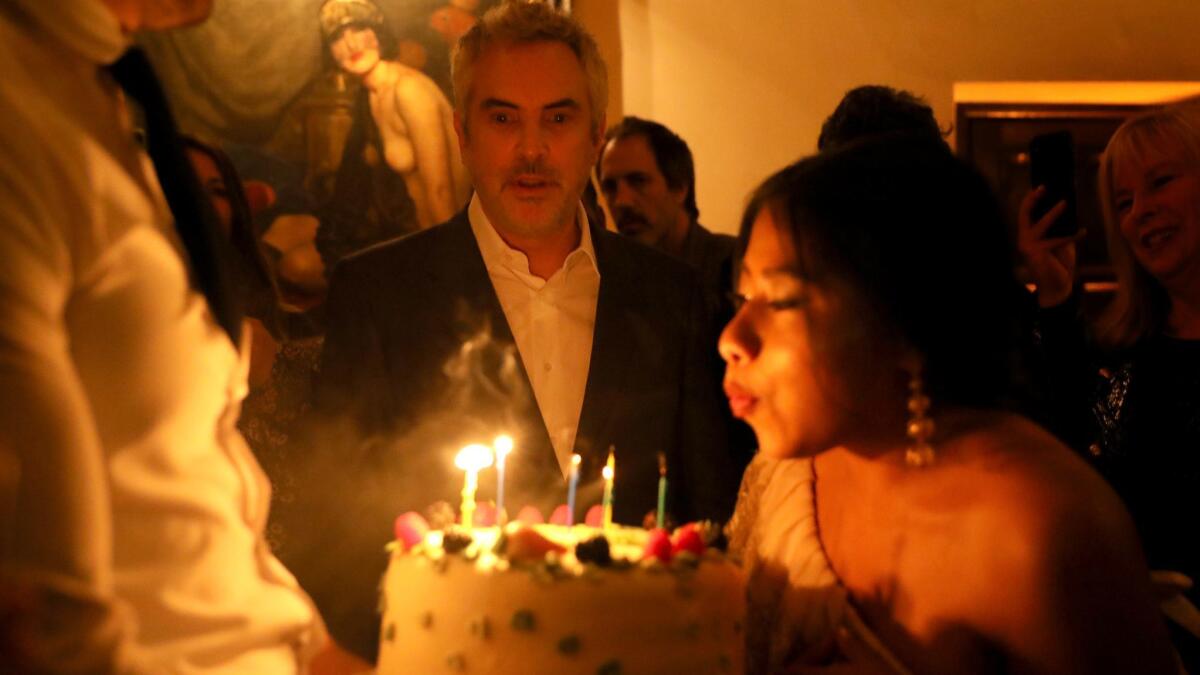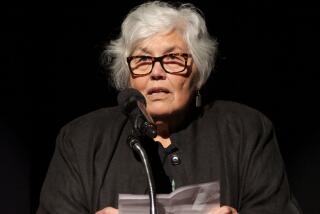Must Reads: ‘Roma’ star Yalitza Aparicio is so much more than her Oscar fairy tale

It’s a story that reads like a fairy tale: Yalitza Aparicio, a young teaching college student, attends a casting call in her hometown of Tlaxiaco, Mexico, at the urging of her older sister. Somehow she gets the role — which is not just any role, but the lead in the critically acclaimed “Roma,” directed by Mexican filmmaker Alfonso Cuarón. The story doesn’t end there. Aparicio not only lands an Oscar nomination for leading actress, she becomes only the second Mexican actress and the first indigenous woman ever to do so.
On a cloudy Friday afternoon early this month, Aparicio, 25, sits resplendent in a geometric print dress, her black hair smooth and gleaming as she sips a glass of pineapple juice in a tony West Hollywood hotel. To say that she never imagined where that casting call would lead is a vast understatement. Aparicio says she had figured that after she completed post-production work on “Roma,” she’d go back to Tlaxiaco and never see Cuaron or the rest of the movie team again.
“But he told me that he would keep seeing me,” she says in Spanish with a wry smile. “I thought he was joking and I even laughed. But the casting director, Luis Rosales, used to also tell me all the time: ‘Just wait, there is more to come. You will see.’”
That also was an understatement.
For her turn as the timid Cleo, a housekeeper contending with heartbreak and personal loss as she tends to the needs of a fractured middle-class family in 1970s Mexico City, Aparicio has been nominated for more than two dozen awards. Her Academy Award nomination is one of 10 potential Oscars for the film, including best picture, director for Cuarón and a supporting actress nomination for Marina de Tavira, who plays Cleo’s boss, Señora Sofia.
‘Roma’s’ Alfonso Cuarón shows us the Mexico City streets that shaped his Oscar-nominated film »
Since the announcement, Aparicio has been on a whirlwind of red carpets and press appearances in both Mexico and the U.S. “This was something,” she says, still looking as if she’s absorbing the news, “I just never expected.”
The narrative that has largely come to define the actress in this avalanche of media coverage has been that of small-town innocent who is plucked from obscurity to the great acclaim of Hollywood. Some have even assumed that her character on the screen is more an extension of her personality than an actor inhabiting a role. It’s a narrative that vastly overlooks her own determination and acuity.
“She’s super sharp,” says Cuarón, who makes the point that to confuse Aparicio with the docile household worker she plays on screen would be a mistake. “She’s completely different than the character she creates with Cleo.”
On the afternoon I meet her in West Hollywood, she is indeed sharp — and warm and witty — despite the fact that she’s been doing photo shoots and interviews for almost seven hours by the time we connect. While the attention that has been heaped upon her has been unexpected, she is keenly aware of the ways in which she has become a symbol for Mexico’s indigenous people.
“Perhaps I haven’t fully absorbed the Oscar nomination,” she says, “but I know that everything that I am doing — if I do something wrong, they might think we are all that way. So I have to take good care of that image, our image.”
People would tell me, ‘Why do you study?’ One, you are a woman. Two, you don’t have the right color.
— Yalitza Aparicio

‘They take you to other worlds’
Aparicio’s story begins in Tlaxiaco, a small agricultural community in the southern Mexican state of Oaxaca that is rich in cultural traditions such as music and dance — but has no movie theater. There, she was born to parents of mixed indigenous heritage: Her father is Mixtec; her mother is Triqui, an ethnicity from the western part of the state. They work as a street vendor and domestic worker, respectively — a family of very modest means.
The chances that Aparicio would become a performer of any kind was always unlikely, but not just for reasons having to do with where she is from. As a girl, she was never filled with the desire to sing in a choir or try out for the school play. “I participated very little in those types of things,” she says.
In fact, she was so retiring that when her teachers approached her about becoming an escolta, the class prefect who carries the flag at assemblies, she was reticent.
“When my mother asked me, ‘Do you want to be an escolta?’ I was, ‘No. I don’t want to parade in front of the entire school,’” she recalls. Though she ultimately did it. “The teachers told me that all children had to learn how to participate.”

Her decision to become a teacher herself was rooted in a number of concerns. There was a desire to help support her family economically, as well as her love of young children. “They take you to other worlds,” she says. “You always learn something from them.”
And there was the knowledge that as a preschool teacher, she would have the power to help mold a child’s life at a time when the love of learning is often instilled. “If I could get a child to really love what they do, and then when I meet him again, he says, ‘Hello, Teacher, I’m a doctor,’ or ‘I’m an engineer,’” she says, “it would bring tears to my eyes to know that I was part of that process.”
In August 2016 she received her pedagogical degree from an area teacher’s college, Escuela Normal Experimental Presidente Lázaro Cárdenas in Putla, about an hour’s drive from Tlaxiaco — just one month before Cuarón invited her to appear in the film.
The fact that Aparicio trained to become a schoolteacher — a normalista, as they refer to pedagogical students in Mexico — is highly symbolic. It was 43 normalistas from a teacher’s college in Ayotzinapa who were taken into custody by local police and ultimately disappeared in 2014, an act that unleashed waves of protest against the government of then-President Enrique Peña Nieto. Normalistas were likewise involved in El Halconazo, the Corpus Christi Massacre of 1971, in which student demonstrators were attacked and killed by an elite military unit in Mexico City — an event that Cuarón depicts to brutal effect in “Roma.”
Aparicio says that part of being a teacher is to set an example for students — and that example extends to human dignity. At the Escuela Normal she attended, the expectation that teachers would fight for their rights was part of the program.
“At the time, everyone was very worked up about the 43,” she says. “And they would tell us, ‘Are you going to stay quiet because a group of young people has disappeared? As if nothing has happened? As if someone erased the cassette and there it stayed? No.’”
Instead, they were taught that if teachers expected their students to demand dignity and respect, then they would have to demand it themselves.
And certainly, that is something Aparicio has done for herself — defying the expectations placed upon her as as an indigenous person, as a woman, as the daughter of working-class parents in an agricultural community that resides far from the centers of power.
“People would tell me, ‘Why do you study?’” she says. “One, you are a woman. Two, you don’t have the right color. Three, your economic station doesn’t help. You’ll end up getting married and becoming a servant.”
“I could stay in this jar where they say I belong, where they tell me, ‘You can only be a servant,’ that you can’t aspire to more,” she adds with dead seriousness. “And sorry to use the word ‘servant,’ but that is how they say it to you.”
In the profiles, Aparicio is often defined by her sweetness. That sweetness harbors a tenacious steeliness.
Yalitza Aparicio on her historic Oscar nod: ‘He reflected us, indigenous people’ »

Looking for an indigenous face
When Cuarón’s casting apparatus rolled into Tlaxiaco in spring 2016, Aparicio was an unlikely candidate for the role not only because she was wary of anything that smacked of public performance, but because she simply wasn’t all that into television or film.
As a kid, she would occasionally catch a bit of an action movie with her father — he was into Arnold Schwarzenegger and ninja flicks — or bits of telenovelas with her mom. But she often preferred to draw or read. (She loves young adult fiction; Alice Sebold’s “The Lovely Bones” is also a favorite.)
She says she simply wasn’t all that enamored of an industry that rarely depicted indigenous life in a meaningful way. “One of the reasons I’m not a big fan of cinema is that one,” she says. “I never found a representation that seemed similar to me or that touched on the ways I was raised.”
The Mexican film and television industries still feature largely white or fair-skinned casts, with indigenous people often cast as extras and often depicted in ways both cartoonish or ignorant. Hollywood doesn’t fare much better. Indigenous people are often invisible in mainstream films; when they do appear, it is often in sidekick roles and generally in historical epics.
In fact, in the nearly 90-year history of the Academy Awards, only two indigenous actors have been nominated for acting awards, both as supporting actors: Chief Dan George (of Tsleil-Waututh heritage), who played the kindly Old Lodge Skins in the 1970 Dustin Hoffman farce “Little Big Man,” and Graham Greene (Oneida), who portrayed Kicking Bird, a curious 19th-century Lakota holy man, in Kevin Costner’s 1990 drama “Dances With Wolves.”
The only known indigenous person to win an Academy Award is singer Buffy Sainte-Marie (Cree), who won for original song in 1983, for co-writing “Up Where We Belong,” the theme from “An Officer and a Gentleman.”
Films produced and starring indigenous people — among them, well-known indies such as Chris Eyre’s 1998 tragicomedy “Smoke Signals” and the critically acclaimed “Atanarjuat,” Zacharias Kunuk’s 2001 family drama inspired by Inuit legend — have been largely overlooked.
But cinema’s lousy history of indigenous representation didn’t have much on Aparicio’s older sister, who prodded Yalitza to see what the casting was all about. Less than six months later, Aparicio was in Mexico City, meeting with Cuarón on the day he offered her and costar De Tavira their parts.
“So many things were going through my head,” she recalls of that moment. “I didn’t have work, I had just graduated, I had to pay back the loans I took to get my degree. I thought, my mother will be proud and I can use this to pay for my expenses.”
She took the role with a line that, as Cuarón reported it to other outlets, has become part of the fairy tale: “I have nothing better to do.”
Her eyes crinkle and she offers a sly smile when I ask her about it. “I was thinking out loud,” she chuckles. “Alfonso tells me all the time now, ‘It’s a good thing you didn’t have anything better to do.’”
Alfonso tells me all the time now, ‘It’s a good thing you didn’t have anything better to do.’
— Yalitza Aparicio
Aparicio not only had no acting experience when she took the role, she hadn’t watched a single one of Cuarón’s films. At the initial castings, she had no idea who he was or his significance. Cuarón, she says, preferred it this way.
“He said, ‘I don’t want you to watch my movies, I don’t want you to contaminate your brain,’” says Aparicio.
The principal thing she did to prepare for the role was to meet Liboria Rodriguez, the woman who had served as Cuarón’s nanny when he was a child, and whose personal tale serves as the inspiration for Cleo in “Roma.” She also mulled over her own mother’s experiences as a domestic worker in Tlaxiaco.
“The first day she was very nervous,” Cuarón recalls. “The second day, she was more relaxed. By the third day, she understood well the mechanics of the set. By the second week she was building a character.”
“As we were doing it, she started making choices that were not the ones I imagined,” he adds. “They were her own choices based on her understanding of the character.”
She wasn’t playing herself on screen; she was becoming an actress.
Aparicio says Cuarón would offer guidance, but it was up to her to conjure Cleo’s emotional responses.
In one scene late in the film — spoiler alert — Cleo sits quietly in her room in the wake of giving birth to a stillborn baby. It is a scene in which Aparicio speaks not with words, but with devastation written all over her face.
“[Alfonso] told me, ‘Remember that this is when Cleo has lost her baby and it is a moment in which so many things are going through her mind,’” Aparicio recalls of Cuarón’s direction. “He touched my shoulder and said, ‘You know.’”
And she did. In that moment she channeled all the womanly pain Cleo could have felt in that moment.
“I don’t have children,” says Aparicio, “but you try to have an understanding of that pain.”
Oscar nominations deliver milestones for Netflix’s ‘Roma,’ Marvel’s ‘Black Panther’ »

A future in Hollywood?
At the moment, Aparicio is still knee-deep in promoting “Roma,” which was released in December. No film offers have been forthcoming, but she says she is thinking of making a go of a career in the movies.
“A movie can make so many people think,” she says. “So I’m hopeful that I can find another role that can provoke discussion about this or other issues.”
“But if it doesn’t happen,” she adds, “it’s been a great experience that will help a lot of people. If I return to teaching, I have other ideas, other things I can share with my students to support them.”
In the meantime, she has made history — with a role that has had a ripple effect throughout Mexican society and beyond. “Roma” has launched discussions about the treatment of domestic workers and indigenous representation. Aparicio has appeared in high-fashion shoots for glossies such as Vogue Mexico, publications where the standard of beauty still leans hard to the white.
“I want to believe that in the future, they will continue to include more and more people like me,” she says, “so that someone else can look at it and say, ‘Hey, I look like her.’”
The Hollywood fairy tale is nice. For this young woman, social change is even better.

Sign up for our weekly Essential Arts & Culture newsletter »
carolina.miranda@latimes.com | Twitter: @cmonstah
More to Read
The biggest entertainment stories
Get our big stories about Hollywood, film, television, music, arts, culture and more right in your inbox as soon as they publish.
You may occasionally receive promotional content from the Los Angeles Times.







